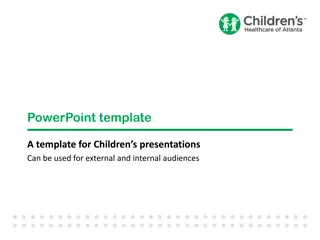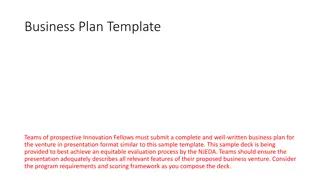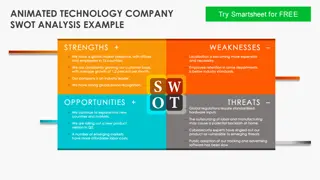Comprehensive Marketing SWOT Analysis for Positive Charge in the EV Charging Market
This marketing SWOT analysis template example provides a visually engaging presentation style to convey critical information about Positive Charge's marketing position. Gain insights into the market landscape, growth opportunities, risks, internal capabilities, and strategic decision-making. Explore strengths like innovative technology and brand reputation, as well as weaknesses such as limited geographic presence and tech integration issues.
Download Presentation

Please find below an Image/Link to download the presentation.
The content on the website is provided AS IS for your information and personal use only. It may not be sold, licensed, or shared on other websites without obtaining consent from the author. Download presentation by click this link. If you encounter any issues during the download, it is possible that the publisher has removed the file from their server.
E N D
Presentation Transcript
MARKETING SWOT ANALYSIS TEMPLATE EXAMPLE Succinctly convey critical information about your company's marketing position to key stakeholders with this marketing SWOT analysis presentation template. The template s visually compelling presentation style ensures that collaborators and project sponsors remain engaged and can easily digest complex data. By presenting insights in an impactful manner (i.e., through the assessment of internal and external factors), this template helps foster better understanding and collaboration, guiding your team toward successful strategizing.
Understand the Market Landscape: Gain insights into where Positive Charge stands in the EV-charging market and how it can capitalize on its strengths while addressing weaknesses. Identify Growth Opportunities: Highlight areas in the market or emerging trends that Positive Charge can leverage to expand its customer base and revenue. Mitigate Risks: Recognize potential threats early on, allowing the company to prepare and adapt strategies to minimize their impact. Align Internal Capabilities: Ensure that the company's strengths align with its strategic goals, and invest in addressing critical weaknesses that might hinder growth. Drive Strategic Decision Making: Utilize the findings from the SWOT analysis to inform key business decisions, guiding the company toward sustainable success.
Innovative Technology: Advanced EV-charging solutions that ensure faster and safer charging experiences for users. Broad Network: Established charging stations in key strategic locations, ensuring widespread accessibility for EV drivers. Eco-Friendly Initiatives: Commitment to sustainable practices, using renewable energy sources for charging, which resonates with environmentally conscious consumers. Strong Brand Reputation: Known for reliability and excellent customer service, making Positive Charge a preferred choice for many EV users. In the Strengths section of your marketing SWOT analysis, detail the unique advantages, assets, resources, and attributes that give the organization a competitive edge in its market. Robust Partnerships: Collaborations with major electric vehicle manufacturers and businesses to increase station visibility and usability.
Limited Geographic Presence: While Positive Charge has strong networks in certain regions, there are still areas that are underserved or untouched by its charging infrastructure. Dependency on Third-Party Suppliers: Reliance on external vendors for some key components can lead to supply chain disruptions or increased costs. Pricing Constraints: Competitive market dynamics may force Positive Charge to adopt pricing that isn't always profitable in the short term. Tech Integration Issues: Some older charging stations might not integrate seamlessly with newer EV models or the UX on mobile apps. In the Weaknesses section of your marketing SWOT analysis, pinpoint the areas of improvement, challenges, and limitations that the organization faces and that might hinder its growth or performance. Brand Awareness: In newer markets, the Positive Charge brand might not yet be as recognizable as some of the more long-standing competitors.
Rising Demand: The global shift toward EVs signifies a growing demand for charging infrastructure. Partnerships: Potential collaborations with businesses (like malls or restaurants) to install charging stations, offering mutual benefits. Innovation: Development of faster charging technologies or green charging solutions powered by renewable energy. Expansion: Penetrating underserved markets or regions with limited EV- charging options. In the Opportunities section of your marketing SWOT analysis, identify external factors or trends that the company can capitalize on for growth, market expansion, or increased revenue. Government Incentives: Leveraging tax breaks or grants meant for green initiatives or infrastructure development.
Competition: New EV-charging companies or established players expanding their networks. Technological Advancements: Rapid changes in EV-charging technology may render existing stations obsolete. Regulatory Changes: Potential legal or regulatory constraints related to EV infrastructure or energy consumption. Infrastructure Limitations: Constraints in power grids or local infrastructure could hinder expansion. In the Threats section of your marketing SWOT analysis, list external challenges, risks, or barriers that might prevent the company from achieving its goals or might adversely affect the firm s operations. Economic Fluctuations: Economic downturns might slow the growth of the EV market, impacting charging demand.
Following a productive quarter, Positive Charge has experienced significant user growth and positive feedback on its advanced charging stations. To further enhance our market presence, we're prioritizing expansion in high- demand areas, researching faster charging solutions, fine- In the Evaluation and Next Steps section, analyze the findings from the SWOT, and then outline actionable strategies to capitalize on strengths and opportunities while addressing weaknesses and mitigating threats. tuning our marketing strategies for regions with slower adoption, and refining our feedback collection processes for better agility and responsiveness.
DISCLAIMER Any articles, templates, or information provided by Smartsheet on the website are for reference only. While we strive to keep the information up to date and correct, we make no representations or warranties of any kind, express or implied, about the completeness, accuracy, reliability, suitability, or availability with respect to the website or the information, articles, templates, or related graphics contained on the website. Any reliance you place on such information is therefore strictly at your own risk.























